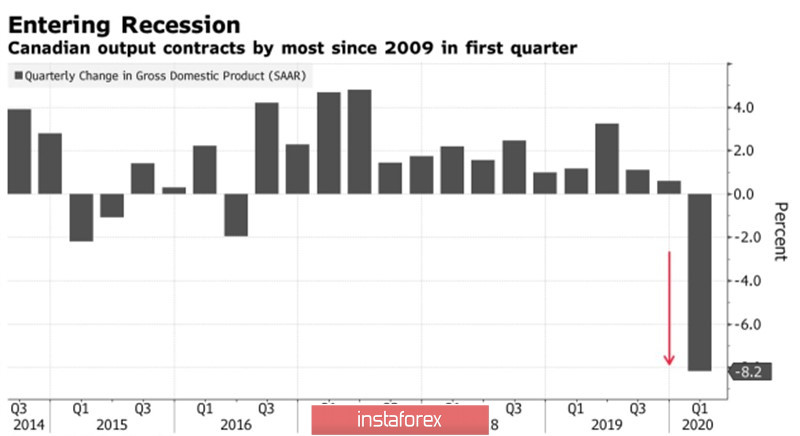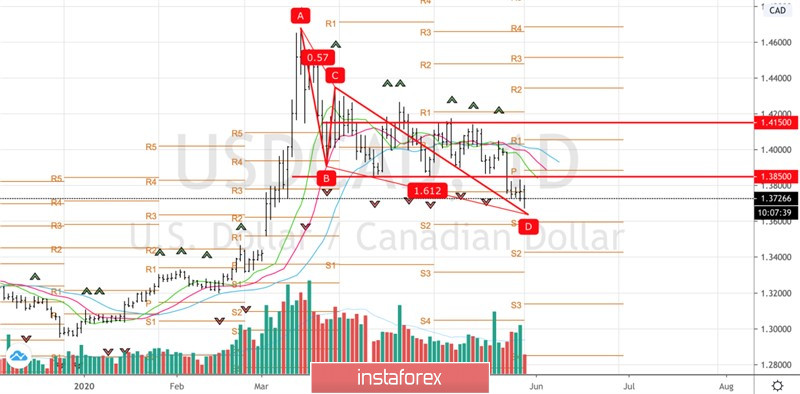The meeting of the Bank of Canada, the release of data on the labor market of the Maple Leaf Country, and expectations of the June OPEC+ summit attract investors' close attention to the Canadian dollar. In May, the "loonie" strengthened against its American namesake by 2.6%, ignoring the sad statistics on GDP for the first quarter, the growth of the BoC balance sheet from CA $ 120 billion in mid-March to CA $ 400 billion, and concerns about a credit rating downgrade that could trigger capital outflows from the securities market of the northern state.
In January-March, the Canadian economy declined by 8.2% y/y to CA $ 2.1 trillion. It was worse only in the first quarter of 2009 when the subsidence was 8.7%. Given the fact that the US GDP decreased by 5%, and in the second quarter, the Maple Leaf Country's gross domestic product may decline by 45%, the USD/CAD pair should have grown in response to the sad statistics. The opposite happened. Bloomberg experts expected -10%, however, they turned out better. Ottawa may be able to avoid the worst-case scenarios in April-June, especially since the government has gone on a large-scale fiscal stimulus.
Dynamics of Canadian GDP

According to the outgoing head of the Bank of Canada, Stephen Poloz, the economy can cope with the consequences of COVID-19, as it was in good shape before the pandemic, although it may take a year or two to return to the trend. According to the IMF forecasts, the Maple Leaf Country's GDP will decline by 6.2% in 2020 and grow by 4.2% in 2021.
Data on May employment may strengthen the view that the worst will be avoided. According to Bloomberg experts, employment will fall by 500 thousand after -2 million in April, and the unemployment rate will rise from 13% to 15%. If the actual statistics are better than expected for both Canada and the US, you can safely sell USD/CAD in the direction of 1.358 and 1.3515. The fact is that the improvement in the US labor market will contribute to the growth of stock indices, increase global risk appetite and reduce the share of safe-haven assets, primarily the US dollar, in investment portfolios. But we must admit that the S&P 500 and oil rallies are the main drivers of the strengthening of the Canadian dollar.
Black gold is steadily moving north on expectations of growth in global demand due to the opening of major world economies. Production in the United States is falling very quickly (for 2 months by 1.6 million b/d or 12%, although adjustments by the US Energy Information Administration can bring the final figure to 2.6 million b/d), and frightened by the fall of WTI below zero, OPEC+ has never previously fulfilled its obligations to reduce production so zealously. It is unlikely that at the summit on June 10, we can expect a repeat of the scenario when the cat ran between Russia and Saudi Arabia and the oil war began.
Technically, the break of the lower border of the "shelf" (the consolidation range of 1.385-1.415) of the "surge and shelf" pattern allowed the "bears" in USD/CAD to take the initiative and send quotes to the target of 161.8% on the AB=CD model. Just below 1.358 are important pivot levels.
USD/CAD, the daily chart

 English
English 
 Русский
Русский Bahasa Indonesia
Bahasa Indonesia Bahasa Malay
Bahasa Malay ไทย
ไทย Español
Español Deutsch
Deutsch Български
Български Français
Français Tiếng Việt
Tiếng Việt 中文
中文 বাংলা
বাংলা हिन्दी
हिन्दी Čeština
Čeština Українська
Українська Română
Română

